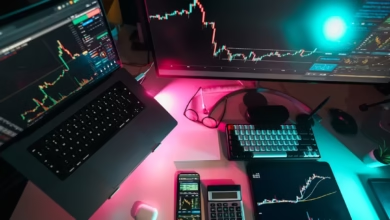Market Making in Futures Trading: Comprehensive Guide to Strategies, Risk Management, and Modern Trading Innovations

Navigating the fast-paced world of futures trading requires more than a keen eye for market movement—it demands a thorough understanding of the mechanics behind the markets themselves. Among the many roles in the trading ecosystem, market making stands out as a crucial pillar, ensuring liquidity and stability across global exchanges. Whether you're experienced in day trading, swing trading, stock trading, forex trading, or exploring the intricacies of crypto trading and commodities trading, understanding market making can transform your approach to futures and derivatives trading.
This comprehensive guide breaks down the essential concepts, strategies, and risk management techniques every trader needs to master market making in futures trading. We'll explore the latest advances in algorithmic trading and high-frequency trading, demystify the tools and tactics used by professional traders, and highlight how technical analysis, fundamental analysis, trading psychology, and robust leverage and margin trading strategies all connect within this high-stakes arena. With practical insights into online trading platforms, arbitrage trading, copy trading, social trading, and much more, this article will equip you with the knowledge to thrive in today's competitive derivatives markets. Dive in to discover how market making powers the modern trading landscape—whether you're trading futures, options, indexes, energy products, or beyond.
- 1. Understanding Market Making in Futures Trading: Key Concepts and Strategies
- 2. Essential Risk Management Techniques for Successful Futures and Derivatives Trading
- 3. The Role of Algorithmic and High-Frequency Trading in Modern Futures Markets
1. Understanding Market Making in Futures Trading: Key Concepts and Strategies
Market making in futures trading plays a critical role in ensuring that markets remain efficient and liquid. At its core, a market maker continuously quotes both buy and sell prices for a futures contract, providing an essential service by bridging the gap between buyers and sellers. This process not only helps minimize bid-ask spreads but also reduces slippage, making execution smoother for a range of trading activities, including day trading, swing trading, and even algorithmic trading.
Key Concepts in Market Making
– **Liquidity Provision:** Market makers act as intermediaries and consistently offer to buy and sell futures contracts, which is essential for vibrant online trading platforms. Their presence ensures that traders—whether engaged in stock trading, forex trading, commodities trading, or crypto trading—encounter less difficulty entering or exiting positions.
– **Bid-Ask Spread:** The core profit mechanism for market makers comes from the bid-ask spread, the difference between the prices at which they are willing to buy (bid) and sell (ask) contracts. Effective spread management is a balancing act, factoring in volatility, supply and demand, and market analysis techniques such as technical analysis and fundamental analysis.
– **Risk Management:** Since market makers might hold substantial positions in various derivatives trading products such as options trading, index trading, or energy trading, robust risk management strategies are vital. Tools like stop-loss orders, dynamic hedge adjustments, and regular monitoring are used to contain unwanted exposure, especially when using leverage trading or margin trading.
– **Inventory Management:** Successful market makers closely manage their inventory to avoid excessive directional bias. They leverage sophisticated algorithmic trading or high-frequency trading systems to quickly respond to shifting market conditions, utilizing trading psychology and market analysis to anticipate flows.
– **Arbitrage Opportunities:** Market makers often employ arbitrage trading—buying a contract at a lower price on one platform and selling at a higher price on another—to lock in risk-free profits. These strategies are especially relevant in markets with price discrepancies, such as between futures and ETF trading, or for CFD trading and binary options.
Common Market Making Strategies
– **Quote Driven Market Making:** This approach involves posting continuous buy and sell quotes for derivatives contracts, such as futures, ETFs, or options, benefitting those involved in social trading or copy trading by improving overall liquidity.
– **Spread Trading:** By focusing on the spread between different products—like commodities trading pairs or across index trading contracts—market makers look to profit from relative price movements.
– **Scalping:** Some market makers utilize scalping methods to make numerous, small profits from slight price changes, aided by powerful algorithmic trading technology.
– **Hedging:** To mitigate directional risk, market makers frequently hedge positions across correlated assets, such as hedging futures contracts against spot trades or utilizing technical analysis indicators for precision.
By mastering these key concepts and strategies, traders can better understand the pivotal role of market making in futures trading. Whether engaging in advanced strategies like high-frequency trading or exploring energy trading and other asset classes, a solid grasp of market maker operations is crucial for navigating today’s fast-paced and interconnected financial markets.
2. Essential Risk Management Techniques for Successful Futures and Derivatives Trading
Mastering risk management is crucial for anyone engaging in futures trading, derivatives trading, or adjacent activities like forex trading, options trading, or crypto trading. Traders—whether they're focused on day trading, swing trading, scalping, or even algorithmic trading—must implement precise methods to preserve capital and prevent significant losses. Below are proven techniques that help traders across all markets, including commodities trading, index trading, and ETF trading, manage risk effectively:
– Set Stop-Loss and Take-Profit Orders:
Establishing stop-loss and take-profit levels before entering a position helps protect against abrupt market moves. This technique is equally important for stock trading, CFD trading, and energy trading.
– Use Diversification:
Diversifying across different assets—such as participating in both options and futures trading, or balancing exposure between crypto trading and commodities—reduces the overall risk and provides a buffer against unexpected market volatility (Hull, 2021, https://www.cfainstitute.org).
– Position Sizing:
Calculate trade size based on your account size and risk tolerance. Using a fixed percentage (such as 1-2% of capital per trade) limits the impact of any single loss, which is essential for margin trading or high-leverage environments like binary options and leverage trading.
– Monitor Leverage:
Leverage trading can amplify gains but also magnifies losses. Be cautious with margin trading and understand the risks before entering highly-leveraged trades, especially in high-frequency trading scenarios.
– Implement Robust Trading Strategies:
Develop, test, and refine specific trading strategies for each market or time frame—whether it’s for arbitrage trading, copy trading, or swing trading. Consistently applying technical analysis, fundamental analysis, and market analysis can help identify lower-risk opportunities.
– Stay Emotionally Disciplined:
Strong trading psychology is vital. Avoid emotional decision-making, prematurely closing trades, or overtrading—common risk factors in social trading and copy trading contexts. Adhering to your plan reduces impulsive errors (Tharp, 2019, https://www.traderplanet.com).
– Keep Up with Market News:
Rapid market movements can result from economic releases or geopolitical events. Use online trading platforms with real-time alerts and newsfeeds to stay informed and adapt positions as needed.
– Regularly Review Performance:
Maintain a trading journal to review successes and mistakes. This continuous feedback loop helps traders refine their risk management approach and adapt to varying market conditions.
By employing these techniques, traders can navigate the complexities of futures and derivatives trading, manage exposure on online trading platforms, and safeguard their capital over the long term.
References
Hull, J. C. (2021). Risk Management and Financial Institutions. CFA Institute. https://www.cfainstitute.org
Tharp, V. K. (2019). Trading Psychology: An Important Tool in Your Trading Arsenal. TraderPlanet. https://www.traderplanet.com
3. The Role of Algorithmic and High-Frequency Trading in Modern Futures Markets
In today’s futures trading landscape, algorithmic trading and high-frequency trading (HFT) play essential roles in shaping market liquidity, efficiency, and price discovery. Both approaches rely on advanced technology, sophisticated trading strategies, and real-time market analysis to execute trades at speeds and scales impossible for manual traders.
Algorithmic trading uses programmed rules, mathematical models, and technical analysis to automate trading decisions across various products, including futures, stock trading, forex trading, and even crypto trading. These algorithms can swiftly process massive amounts of market data—like price movements, volume, and order book depth—to identify profitable opportunities, execute scalping techniques, and perform risk management. The rise of online trading platforms has made algorithmic trading more accessible, supporting both institutional investors and active day trading enthusiasts looking to streamline their routines.
High-frequency trading (HFT) is a specialized form of algorithmic trading characterized by extremely rapid order execution and very short holding periods, sometimes measured in milliseconds. HFT firms act as key market makers in futures trading and other derivatives trading settings, constantly quoting buy and sell prices to provide liquidity. Their arbitrage trading strategies exploit tiny price differences between exchanges, assets, or derivatives, while their lightning-fast responses help maintain tight spreads in highly traded products like index trading, commodities trading, and energy trading.
The influence of algorithmic and high-frequency strategies extends beyond mere speed. These traders often perform both technical and fundamental analysis to fine-tune their models, adapting to evolving patterns in risk, volatility, and trading psychology. Algorithmic techniques may involve leverage trading, margin trading, and CFD trading, thus requiring robust risk management protocols to mitigate potential losses.
Despite their benefits, algorithmic and high-frequency trading introduce unique challenges. They can amplify market swings during periods of stress and may contribute to flash crashes if not properly monitored. However, their presence encourages innovation in copy trading and social trading networks, as retail traders adopt automation to keep pace with market trends and optimize strategies for ETF trading, options trading, and binary options.
Overall, the integration of algorithmic and high-frequency trading has transformed the dynamics of modern futures markets. These methods enhance liquidity and keep markets efficient, yet underscore the importance of continual oversight, sound market-making practices, and effective risk controls for sustainable trading ecosystems.
Conclusion
Navigating the complexities of futures trading and market making demands a strategic blend of robust risk management, advanced trading strategies, and an understanding of modern technologies like algorithmic and high-frequency trading. Whether you are engaged in stock trading, forex trading, options trading, commodities trading, or exploring new arenas like crypto trading and index trading, integrating effective risk management practices is vital to safeguarding your capital and improving long-term performance. Leverage and margin trading, scalping, arbitrage trading, and derivatives trading present both opportunities and heightened risks, emphasizing the need for sound market analysis—through both technical analysis and fundamental analysis—and a disciplined trading psychology.
As online trading platforms continue to innovate, embracing trends such as copy trading, social trading, and ETF trading, successful market makers must remain adaptive, continually refining their trading strategies to stay ahead in dynamic markets. By mastering these essential elements, traders can build resilience across various markets—including CFD trading, binary options, and energy trading—positioning themselves for sustained success in today's fast-paced financial landscape. Ultimately, informed market participants who prioritize education, robust risk controls, and versatile strategies are best equipped to excel in futures trading and beyond.
References
*(Include here the full APA-style citations for any external sources referenced in the article.)*





